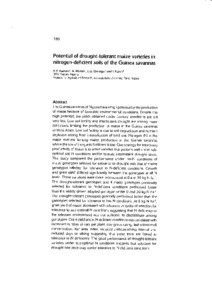| dc.contributor.author | Kamara, A.Y. |
| dc.contributor.author | Menkir, A. |
| dc.contributor.author | Omoigui, L.O. |
| dc.contributor.author | Kureh, I. |
| dc.date.accessioned | 2019-12-04T11:14:23Z |
| dc.date.available | 2019-12-04T11:14:23Z |
| dc.date.issued | 2007 |
| dc.identifier.citation | Kamara, A.Y., Menkir, A., Omoigui, L.O. & Kureh, I. (2007). Potential of drought-tolerant maize varieties in nitrogen-deficient soils of the Guinea savannas. In Fifth biennial regional maize workshop: demand-driven technologies for sustainable maize production in West and Central Africa (pp. 180-193), 3-6 May, Cotonou, Benin. |
| dc.identifier.uri | https://hdl.handle.net/20.500.12478/2750 |
| dc.description.abstract | The Guinea savannas of Nigeria have a high potential for the production of maize because of favorable environmental conditions. Despite this high potential, the yields obtained under farmers' conditions are still very low. Low soil fertility and intermittent drought are among major constraints limiting the production of maize in the Guinea savannas of West Africa. Low soil fertility is due to soil degradation and nutrient depletion arising from intensification of land use. Nitrogen (N) is the major nutrient limiting maize production in the Guinea savannas where the use of inorganic fertilizers is low. One strategy for improving productivity of maize is to select varieties that perform well under sub-optional soil N conditions and/or tolerate intermittent drought stress. This study compared the performance under low-N conditions of maize genotypes selected for tolerance to drought with that of maize genotypes selected for tolerance to N-deficient conditions. Growth and grain yield differed significantly between the genotypes at all N levels. These variations were more pronounced at 0 and 30 kg N ha-1. The drought-tolerant genotypes and 4 maize genotypes previously selected for tolerance to N-deficient conditions performed better than the widely grown adapted genotype under 0 and 30 kg N ha-1. The drought-tolerant genotypes generally performed better than the genotypes selecetd for tolerance to low N-conditions. At 0 and 30 0 kg N ha-1, grain yield of maize decreased with advances in cycles of selection for tolerance to sub-optimal N conditions suggesting that N deficiency in the selection environment was not sufficient to discriminate among genotypes. Grain yield under N-deficient conditions was correlated with increased number of ears per plant, stay-green rating, leaf chlorophyll concentration, leaf area index, reduced anthesis-silking interval and reduced days of silking suggesting that these traits are linked to tolerance to N deficiency. The good performance of drought-tolerant varieties under sub-optimal N conditions suggests that selection for drought tolerance may confer tolerance to N-deficient conditions. |
| dc.description.sponsorship | United Nations Development Programme |
| dc.description.sponsorship | International Fund for Agricultural Development |
| dc.format.extent | 180-193 |
| dc.language.iso | en |
| dc.publisher | International Institute of Tropical Agriculture |
| dc.subject | Maize |
| dc.subject | Drought |
| dc.subject | Ecological Zones |
| dc.subject | Savannas |
| dc.subject | Soil Fertility |
| dc.subject | Maize Production |
| dc.title | Potential of drought-tolerant maize varieties in nitrogen-deficient soils of the Guinea savannas |
| dc.type | Conference Paper |
| dc.description.version | Peer Review |
| cg.contributor.affiliation | International Institute of Tropical Agriculture |
| cg.contributor.affiliation | Ahmadu Bello University |
| cg.coverage.region | Africa |
| cg.coverage.region | West Africa |
| cg.coverage.country | Nigeria |
| cg.authorship.types | CGIAR and developing country institute |
| cg.iitasubject | Maize |
| cg.iitasubject | Plant Production |
| cg.iitasubject | Soil Fertility |
| cg.iitasubject | Soil Health |
| cg.howpublished | Formally Published |
| cg.publicationplace | Ibadan, Nigeria |
| cg.accessibilitystatus | Limited Access |
| local.dspaceid | 93772 |
| cg.targetaudience | Scientists |

